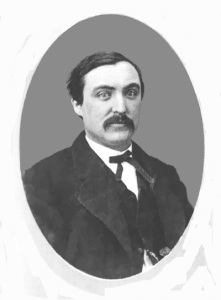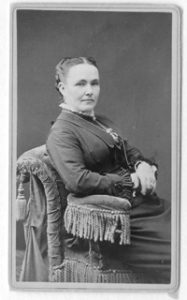Pioneer Profiles – March 2015
Since March 17th celebrates St. Patrick and all things Irish, it seems appropriate for this month’s Pioneer Profiles to feature Jeremiah Nunan, one of Jacksonville’s Irish pioneers. Most people associate Nunan’s name with his elaborate Queen Anne style home on North Oregon Street, one of the town’s most photographed historic landmarks. But there is more to Jeremiah Nunan’s story than a house.
Nunan, called Jerry by his friends, was born in Ireland around 1843. The whole family immigrated to America probably during the Great Famine years of 1845 to 1852 when blight ravaged Ireland’s potato crops, the sole source of sustenance and income for two-fifths of the population.
Like many young men, Nunan heard the call of the West, reaching Jacksonville in 1865. After looking around, he decided to open a saddlery shop in competition with Henry Judge. However, Judge and Nunan soon became good friends. And it was through Judge that Nunan met his future wife, Delia O’Grady.
Many stories have been told about Nunan and Judge marrying Irish sisters who were mail order brides. However, Delia and her older sister Anna had emigrated from Ireland with their family, settling in Oakland, California, where Judge met and married Anna. Henry and Anna already had four children when Anna introduced Jeremiah to Delia. Jeremiah and Delia were soon married by Father Blanchett at St. Joseph’s Catholic Church on June 3, 1872.
Shortly afterwards, Nunan and Judge became partners in the saddlery and harness business, selling and repairing “harnesses, halters, horse collars, saddles, and black snake whips.” The partnership lasted three years before Judge decided to move his family back to San Francisco. When Judge returned in 1878, Nunan sold him the business in order to seek “some business with less confinement.”
By 1881, Nunan was dealing in general merchandise and apparently quite successful. Various 1882 Democratic Times newspaper articles reported that, “J. Nunan’s goods are arriving in reckless profusion;” that Nunan’s store was “running over with a superior assortment of general merchandise;” and that “J. Nunan has just received one of the largest and best stocks of goods ever brought to Southern Oregon and is too busy attending to customers to write an advertisement.”
However, Nunan was not so busy as to neglect his civic responsibilities. In 1876 he was elected a town trustee and by 1881 was serving as city recorder and as police judge where he gained a reputation as “the terror of evil doers.” He also was one of the incorporators of the Jacksonville Branch of the O. & C. Railroad, the town’s initial effort to connect Jacksonville with the main railroad line being laid through the valley.
Nunan’s thriving mercantile business also allowed him to invest in other holdings. He purchased property, acquired agricultural land and stock, and laid claims to several quartz mines, becoming President of the Jacksonville Milling and Mining Company. He also sold fire insurance, “resident agent for the wealthiest and most reliable fire insurance companies on the coast.”
Between 1879, when Bradstreet’s Reports listed Nunan’s net worth as $3,000 to $5,000 and his credit rating as “fair,” and 1903, when Jacksonville listed Nunan as one of its “heaviest taxpayers,” Nunan became one of Jacksonville’s wealthiest residents.
However, for the first 20 years of their marriage, the Nunans had continued to live in the small house on 5th Street where they had moved after their wedding. With five children, the house was bursting at the seams. So in 1892, Jeremiah decided to give Delia a special Christmas present—a new house that reflected his status and influence.
The lovely 16-room, Queen Anne style home that Nunan commissioned was the last of three houses in Jacksonville based on designs by Tennessee architect George F. Barber. The plans were purchased directly from Barber’s “The Cottage Souvenir” catalog, hence its nickname, the “catalog house.”
Despite rumors to the contrary, only the plans and the fancier woods were brought in by rail. Most of the materials and workmanship were local: H.F. Wood was the contractor; Henry Klippel’s sawmill supplied most of the wood; J. Weeks and Sons of Medford carved the five intricate fireplace mantels.
Nunan retired from his mercantile business in 1911, turning its operation over to his son Charles. A year later, Jeremiah and Delia sold their beautiful home and moved to Oakland, California. In 1916, while visiting Charles, Jeremiah took his own life. His death was attributed to “temporary insanity, caused by ill health,” allowing Nunan to be interred in the Catholic section of Jacksonville’s Pioneer Cemetery. At the time of his death, the Jacksonville Post wrote that Nunan “was known to almost everyone in Jackson County and highly esteemed by all.”
So perhaps the Nunan House is an appropriate legacy for Jeremiah. It has been described by respected architectural historian Marion Ross as a “wilder and less domesticated” version of the Queen Anne style with the house’s “unabashed exuberance” representing both Jacksonville’s “history of lusty gold mining and productive agriculture” as well as Jeremiah Nunan’s own character and enterprise.
Pioneer Profiles is a project of Historic Jacksonville, Inc., a non-profit whose mission is helping to preserve Jacksonville’s Historic Landmark District by bringing its buildings to life through programs and activities. Visit us at www.historicjacksonville.org and follow us on Facebook (historicjville) for upcoming events and more Jacksonville history.



What a wonderful and interesting story, and I just fell in love with this house, so amazing to say the least.
We lived on Applegate St within walking distance of this treasure.
I was disappointed this narrative did not include the local folklore…As I understand it, the family had terrible health problems once they moved in. Their children were violently ill and tragically some died. I believe Mrs. Nunan also succumbed to what was perceived as a “curse” for Mr. Nunan’s business dealings….
Mr. Nunan, his heart broken from the loss of his family, committed suicide.
Years later, when repair was being done to the roof, the original plans were found.
The mystery of the Nunan curse was discovered.
Their misfortune was due to having LEAD pipes that slowly poisoned them.
Hi Peg: We checked on this with Carolyn Kingsnorth and here is her reply:
The Nunan’s son, Edward, died at age 20 from a fall from a horse. Their daughter, Ella Rose, died in San Francisco where she was attending Heald’s Business College. Supposedly it was from ice cream that had been left in a tin too long–that’s where the lead poisoning story comes in.
Some of the earlier restorers of the house who first opened it as a B&B invented some elaborate stories. They were the ones who created the story that the house came from a Sears Roebuck catalog and had been shipped her on 17 freight cars. That may also be where idea of lead pipes comes from. (The current Flint, Michigan lead pipe problems may have also planted the idea.)
It is true that Jeremiah Nunan committed suicide while visiting his son Charles here. He apparently was severely depressed (one story I’ve heard said it was because his wife and daughters had almost spent him into bankruptcy–can’t verify that either), which is why the Catholic Church gave him absolution and he was allowed to be buried in hallowed ground.
Charles’ property is/was the big farm/ranch at the corner of South Stage Road and Bellinger Lane where you see Cheryl Garcia’s big metal poppies. Most of it is now leased to Quail Run Vineyards (South Stage Cellars) for vineyards. There’s an oak savannah at the top of the hill where the home is. Nunan took his life under one of the oaks. And again I’ve heard 2 stories–one is that he hung himself; the other is that he shot himself.
What can I say–everyone likes a good story, and usually the more scandalous, the better!
Carolyn Kingsnorth
Will you please provide sources for your research and writing on the Nunan house.
Please contact the author directly – contact info is provided in the About the Author section of this post. Thank you!